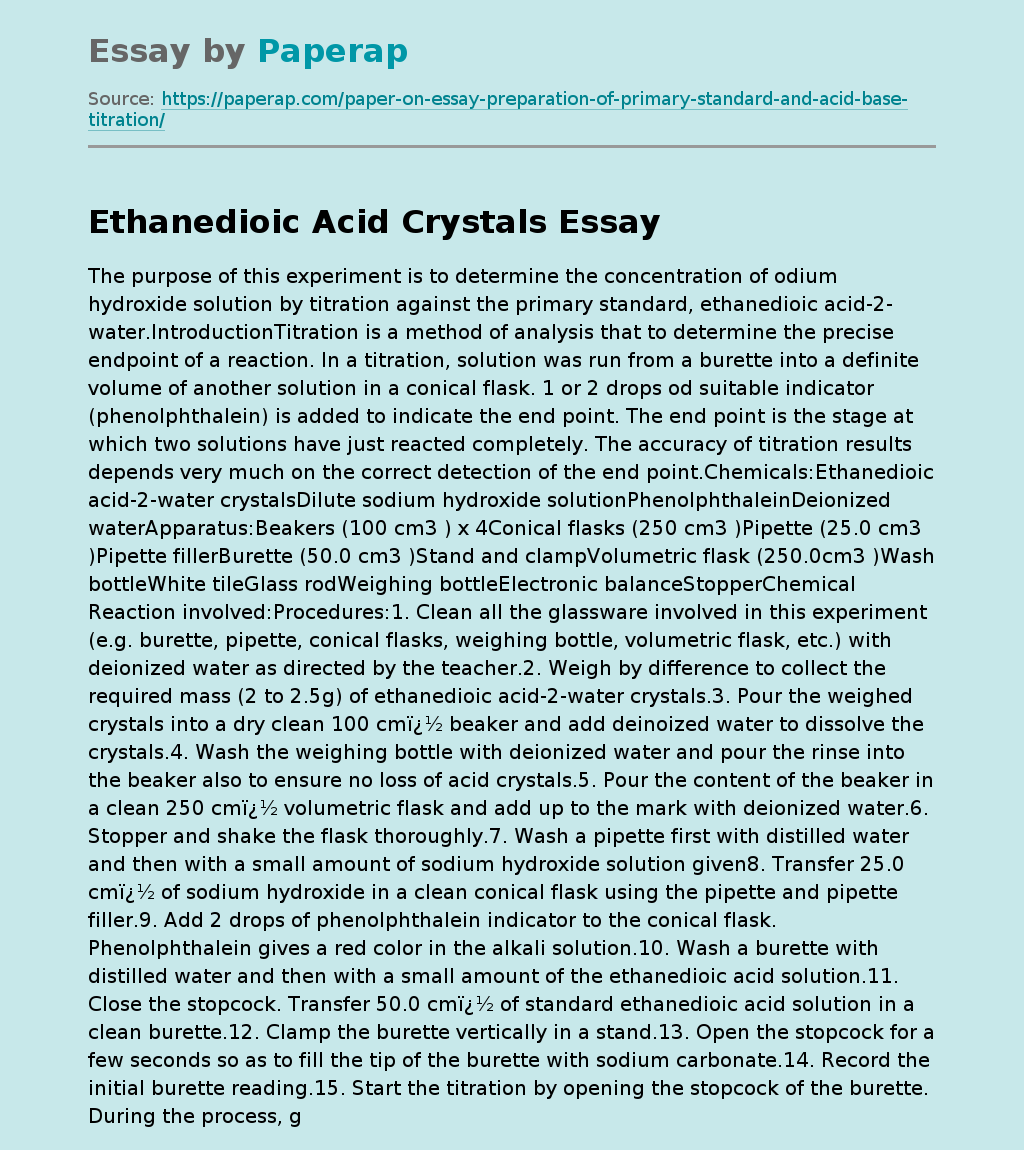The purpose of this experiment is to determine the concentration of odium hydroxide solution by titration against the primary standard, ethanedioic acid-2-water.IntroductionTitration is a method of analysis that to determine the precise endpoint of a reaction. In a titration, solution was run from a burette into a definite volume of another solution in a conical flask. 1 or 2 drops od suitable indicator (phenolphthalein) is added to indicate the end point. The end point is the stage at which two solutions have just reacted completely.
The accuracy of titration results depends very much on the correct detection of the end point.Chemicals:Ethanedioic acid-2-water crystalsDilute sodium hydroxide solutionPhenolphthaleinDeionized waterApparatus:Beakers (100 cm3 ) x 4Conical flasks (250 cm3 )Pipette (25.0 cm3 )Pipette fillerBurette (50.0 cm3 )Stand and clampVolumetric flask (250.0cm3 )Wash bottleWhite tileGlass rodWeighing bottleElectronic balanceStopperChemical Reaction involved:Procedures:1. Clean all the glassware involved in this experiment (e.g. burette, pipette, conical flasks, weighing bottle, volumetric flask, etc.) with deionized water as directed by the teacher.
2. Weigh by difference to collect the required mass (2 to 2.5g) of ethanedioic acid-2-water crystals.3. Pour the weighed crystals into a dry clean 100 cm� beaker and add deinoized water to dissolve the crystals.4. Wash the weighing bottle with deionized water and pour the rinse into the beaker also to ensure no loss of acid crystals.5. Pour the content of the beaker in a clean 250 cm� volumetric flask and add up to the mark with deionized water.6. Stopper and shake the flask thoroughly.7. Wash a pipette first with distilled water and then with a small amount of sodium hydroxide solution given8.
Transfer 25.0 cm� of sodium hydroxide in a clean conical flask using the pipette and pipette filler.9. Add 2 drops of phenolphthalein indicator to the conical flask. Phenolphthalein gives a red color in the alkali solution.10. Wash a burette with distilled water and then with a small amount of the ethanedioic acid solution.11. Close the stopcock. Transfer 50.0 cm� of standard ethanedioic acid solution in a clean burette.12. Clamp the burette vertically in a stand.13. Open the stopcock for a few seconds so as to fill the tip of the burette with sodium carbonate.14. Record the initial burette reading.15. Start the titration by opening the stopcock of the burette. During the process, gently swirls the conical flask continuously to mix the two solutions. At the time when the color changes from red to colorless, close the stopcock immediately.16. Record the final burette reading.17. Calculate the volume of ethanedioic acid required to neutralize 25.0 cm� of sodium hydroxide.18. Empty the conical flask and wash it with water.19. Repeat the steps 3 or4 times until the results from each trial are agreed.20. After the experiment, rinse all the glassware used with tap water and put them back to their original positions.Results:Titration ResultsTitration1st (Trial)2nd3rd4thInitial reading (cm�)0.0017.000.0015.50Finial reading (cm�)15.832.2015.5031.00Volume of titrant (cm�)15.815.2015.5015.50Average volume of ethanedioic acid reacted:(15.20+15.50+15.50)/3 cm�= 15.40 cm�That mean15.40 cm� of ethanedioic acid is used to titrate 25.0 cm� of sodium hydroxide.Discussion:1. Mass of ethanedioic acid crystals used:= 2.50 gNo. of moles of ethanedioic acid:= 2.50/ (12.0×2+1.0×2+16.0×4)= 0.02778 moleMolarity of ethanedioic acid= 0.02778/0.250= 0.11112MNo. of mole needed:= 0.11112 x (15.40/1000) = 1.711 x 10��Equation:Mole ratio of C2H2O4 to NaOH is 1:2.No. of moles of NaOH needed:= 1.711 x 10�� x 2= 3.422 x 10��No. of mole = molarity x volume3.422 x 10�� = molarity x (2.5 / 100)molarity = 0.137MConcentration of the sodium hydroxide is 0.14 mol/dm��2. 3 requirements of a primary standard solution:i) The solid dissolved in water should be pure.ii) The molarity of the solution should be known.iii) The solid must be dissolved completely.3i) There is no effect if the burette is not rinsed with ethanedioic acid solution since we know the no. of mole of the ethanedioic acid and the volume of sodium hydroxide.3ii) If the tip of the burette is not filled before titration begins, more acid is needed to titrate sodium hydroxide. By the mole ratio, since the no. of mole of sodium hydroxide is larger, and thus the molarity of calculated will be larger.3iii) If the conical flask contains some distilled water before the addition of sodium hydroxide, the molarity calculated will be larger since the volume of sodium hydroxide increase.4. It is advisable not to use sodium hydroxide solution to fill the burette in this experiment because alkaline will corrode glass and burette is expensive, therefore sodium hydroxide is usually placed in the conical flask.Improvements:1. Graduation mark of pipette and volumetric flask should be accurately reached.2. Just add enough indicator solutions, not too much.3. Ensure stopcock has been closed before filling.4. Remember to fill up the tip of burette.5. Fix the filled burette perfectly vertical.6. Stopcock should be controlled by thumb, first and second fingers of left hand7. Swing the flask gently and continuously.8. Slow down the adding of solution when end-point is close.9. There should be no hanging drop of solution on the tip.10. The spectula should be put back the original place, to prevent the ethanedioic acid-2-water be contaminated.Conclusion:The concentration of sodium hydroxide calculated is 0.137M (correct to 3 sig. fig.)
Ethanedioic Acid Crystals. (2019, Dec 05). Retrieved from https://paperap.com/paper-on-essay-preparation-of-primary-standard-and-acid-base-titration/

